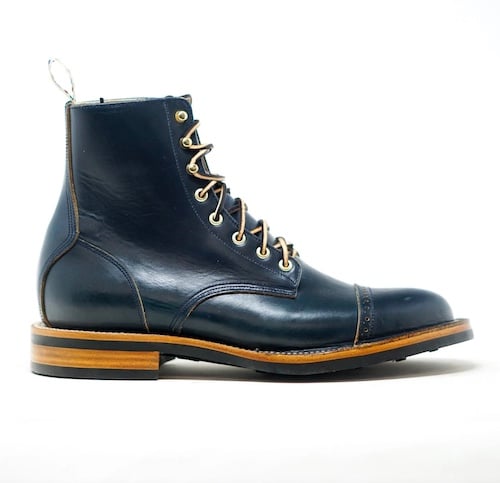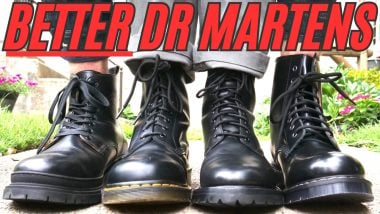Unmarked Boots Review | Luxury Casual for Under $500
Constructed in Leon, Mexico, the so-called “Shoe Capital of the World” (or at least of the Americas), Unmarked have developed something of a cult following. Fans rave over their high-quality, relative affordability, and killer style, and while I had never worn the brand before this pair arrived at my doorstep, I have friends who swear by them. So I was very excited to try out a pair for myself.
I approached their DB Hunter Cap Toes as being a worthy competitor to the venerable Viberg Service Boot or the White’s MP Sherman — both preeminent, fashionable-yet-tough casual boots that cost $700 to $800 — and as such I walked in with high expectations.
What I found was an impressive boot, well-built with first-rate materials and obvious passion. The overall impression left by these boots is overwhelmingly positive and I highly recommend them.
Let’s dig into the details because there was a lot to love here.
Unmarked Boots Pros and Cons
If you don’t have time to dive as deeps as we like to, no sweat: here’s a quick summary of Unmarked’s Hunter boot.
Pros
- Sought after hallmarks of high quality, laboriously made boots: Horween leather, Dr. Sole outsoles, and handsewn stitchdown construction
- Well priced for the quality and materials due to Mexican origin
- Very water resistant and resoleable
- Unique design elements such as higher shaft, eyelet and speedhook design, pull tab
This brand stands out for having unusually reputable leather, skillful construction, and refined designs for a Mexican boot, making the sub $500 price tag a serious steal.
Cons
- 6 weeks to make them unless they have your size on hand (unlikely)
- Heavier than your standard welted boot
- Some quality control issues with regard to cosmetic elements like stitching alignment
- Price may be too high for some buyers; it’s well priced for what you get, but the average person might not be swayed by the higher end, higher cost details

A First Glance at Unmarked’s DB Hunter Boot
- Horween Chromexcel® leather uppers
- Calfskin lined
- Dr. Sole® studded outsole
- Handmade, 360-degree Stitchdown construction / nailed with brass pegs
- Brass eyelets
- Rawhide, alum tanned leather laces
- Substantial, heavy feeling
While Unmarked is a new brand for me I immediately recognized many familiar hallmarks of high-end boots I have known and loved for years. Made with Horween’s signature Chromexcel® leather, paired with Dr. Sole® studded rubber outsoles, and held together with stitchdown construction, the DBs feel like a heritage-lover’s dream.
Taking them out of the box they definitely felt substantial, even a tad heavier than the average service boot. The details are lovely, from the soft calfskin lining to the double-row stitching to the “small punch” perforations on the cap toe. The leather exhibited no major scuffs on the toe or the heel, areas bootmakers are most prone to nicking. There were no obvious signs of poor construction or production mistakes. The toe was structured while the brass eyelets and speed hooks were a bright brass, lending the boots a slightly more polished look.
The outsole was not only stitched into place but also reinforced with at least twenty brass pegs, which was an interesting touch. (You might call that element overkill or you might love it, depending on how much you like your boots to be overengineered.)
Trying them on the first time I found the boot opening to be narrower than usual, so the shaft hugged my leg a bit closer than usual. I did not mind the look of this feature at all since I prefer to wear more tapered pants, but when first breaking the boots in, the upper portions of the boot tended to rub on my lower calf and made them slightly uncomfortable at times. But this discomfort faded with more wear as the leather continued to stretch and soften.

What Is a “Derby Boot”?
- A casual boot that contrasts with dress boots and oxford shoes
Okay so this part is going to get a little nerdy and deal in semantics, but stick with me.
Unmarked calls this a derby boot. What makes a boot or a shoe a “Derby,” you might ask? Well, the biggest thing is that it has “quarters.” These are pieces of leather on the sides of the upper that are sewn on top of the vamp and have the eyelets attached to them.
“What is the vamp, though?” That is the part of the upper that covers the front of the foot, above the toe box. Derbies with quarters contrast with oxfords, which do not have quarters and instead have the eyelets incorporated as part of the vamp itself. In general, Oxfords are more formal, and Derbys are more informal.

Technically, while many boots have quarters, they may not call themselves derbies. For instance, Viberg Service Boots, White’s MP Shermans, and Oak Street Trench Boots all have quarters sewn on top of the vamp, but the makers do not call these “derby” boots. Viberg, for their part, does sell a derby boot but draws the distinction between this style and their service boots by incorporating dressier elements such as French binding and blind eyelets. (Still, to the casual observer, the two styles look very similar.)
So, while the DB Hunter are called derby boots, they share many stylistic elements with military-inspired service boots.

What sets these Unmarked boots apart from other similar heritage boot styles? There are a few subtle design choices that I noticed and appreciated.
First, the height of the boot’s shaft. Compared to a Viberg Service boot, the top of the boot is an inch and a half taller, creating a much more striking look.
Second is the number of eyelets and speed hooks. These DB Hunters feature five eyelets and three speed hooks, but given the height of the shaft, the hooks and holes are slightly further apart, creating a unique appearance.
Finally, the pull tab is not leather but instead made of a synthetic material with a stitched pattern. These subtle touches make the boots quite recognizable and appears to be a kind of subtle branding element.
Unmarked Boots’ Leather
- Navy-dyed Chromexcel®
- Combination tanned leather: chrome-tanned and then vegetable bark re-tanned
- Used by all the world’s best bootmakers including Viberg, Rancourt, Allen Edmonds, Thursday, Grant Stone, Oak Street
- Wipe with microfiber cloth and then use horsehair brush to buff
- Venetian Shoe Cream to condition
You certainly cannot go wrong choosing Chromexcel® from Chicago’s Horween Leather Company for the upper on a boot. Known for its exceptional quality, durability, and beautiful patina, the leather is used by countless high-end bootmakers.
While I own several pairs made using “CXL,” this was my first experience with Horween’s navy blue version — or any navy-colored leather. But the navy Hunter may be Unmarked’s flagship boot, as it’s often seen in their marketing, so it felt like the right model to pick up. I generally view any boot that is not a shade of brown or black to be something of a bold choice, but these felt pretty versatile and right at home paired with blue jeans.
I also appreciated the natural colored midsole and heel, which helped break up the darker colored elements of the boot and created a beautiful contrast. With a few wears my navy leather began to exhibit creases and molded nicely to my foot.

Of course, this boot is available in a range of leathers including natural vegetable tanned Essex leather (also from Horween), black and brown Chromexcels, and a couple of other variants like olive waxed suede and brown pull up — those two leathers are local (one from Lefarc) but they’re $70 less expensive, so no harm no foul.
Leather Care
Because CXL is full of various kinds of waxes, oils, and greases it does not need to be, and frankly should not be, conditioned too often. When you do condition (roughly 2-3 times annually) apply some Venetian Leather Balm by hand and then brush and buff. Give them a clean when they’re looking dusty by wiping them down with a microfiber cloth or a wet rag and brushing them with a horsehair brush.

Unmarked Hunter Boots Outsole and Construction
- Handsewn stitchdown construction
- Veg tan leather insole and midsole
- Cork filling
- Steel shank
- Dr. Sole outsole
In the world of high end boots, two names reign supreme for rubber outsoles: Dr. Sole and Dainite. Dr. Sole is harder to find and therefore tends to be more coveted among boot guys, so I was happy to see them on my Hunters.
I found the outsole to be a slightly heavy but robust choice that helped the boots perform well in poor weather. I took them for a short hike through the woods and found no real problems maintaining my footing on muddy hills and high grass. The Dr. Soles had excellent traction and have so far displayed very little wear.
Overall, I found them nearly indistinguishable from the Dainite® studded rubber sole favored by Tricker’s, Crockett & Jones, Viberg, and many other high-end makers. They have a nice low profile and the dark color created a nice contrast with the boot’s lighter colored midsole and heel. I found myself wondering if a slightly more rugged sole like a Ridgeway would have flattered the boots a bit more, but in the end I have little issue with the choice of a studded sole.

Unmarked vs Viberg Boots
The Viberg service boot and the DB Hunter are similar in that they’re casual lace up boots made with stitchdown construction, rare outsoles with cult followings (Dainite and Dr. Sole, respectively), both brands are best known for their Chromexcel service boots, and both of them target the “luxury casual” niche. They even weigh the same amount: about 900 grams.
But Vibergs are currently $860 and the DB Hunter is $490.
Since Viberg customers might consider looking at Unmarked, let’s compare them.
I have two pairs of well worn Viberg service boots and the quality control is excellent: the stitching is perfectly spaced and while Chromexcel is famous for loose grain — so much so that I don’t really consider loose grain to be a flaw on Chromexcel boots — the Vibergs have none at all.

(I’ve been told that’s a coincidence and that there are grainy Vibergs out there. I’m sure that’s true, but it’s also clear to me that they have excellent “clicking,” or leather selection standards, at Viberg.)
This isn’t the case on Unmarked’s boots, which have plenty of loose grain, but again, I don’t really fault them for that since it’s just so common on Chromexcel.
But there are still some issues that, while cosmetic, the Viberg customer would take issue with. The stitching isn’t always evenly spaced, but most critically, the backstay is on crooked.

See how on the right boot, the back piece is wonky and the pull tab isn’t dead center?
Sure, this stuff is cosmetic, but I understand that that’s the kind of thing that matters to the luxury boot buyer. Then again, these boots are half the price of Viberg, so there’s a case to be made that it’s a reasonable sacrifice for almost Viberg quality. Just don’t think of Unmarked as a perfect substitute.

Unmarked Boots Sizing and Fit
- Order true to size
- Unadvertised EE widths available, just put it in the order notes
I found the DB Hunter to be true to my Brannock size (11.5D). This tracks with what I have read and heard from other Unmarked boot owners. They recommended that I communicate directly with the brand on sizing, and contact information is available on the brand’s website. They’re also quite responsive on Instagram.
That being said, the site is a bit confusing with regards to the proper fit. It states that “we recommend to size up for in between sizing” which seems to suggest that the boots may run slightly small. In another place they offer a size conversion chart, but without a point of reference (i.e. they run large, small, true to size) for how the boots are supposed to fit, this chart isn’t terribly helpful. They also warn that sizing “may vary depending on the style, design, material and last” which can also cause concern for potential buyers.
I found the fit to be very similar to Viberg’s 2030 last, in which I wear 10.5. It was snug without being uncomfortable, and there was no heel slip. As stated above I did experience some discomfort with the shaft of the boot rubbing on my calf. I may just be unaccustomed to a boot that hit a bit higher on my leg but overall this is a minor inconvenience, particularly if you get tall boot socks.

Unmarked Boots Price
- $490 for US leathers, $420 for local leathers
At $490, these boots are not cheap, but they’re cheaper than almost any other brand making boots of this quality.
It may be surprising to see a boot from Mexico priced so high. But when the product itself is compared to other high-end North American competitors such as Viberg, Alden, or White’s, the Unmarked Derby Boots are certainly more affordable and the quality of the product is pretty damn close. I can completely see why some boot fans would value a young company building great boots in small batches and taking on the big names.
This brand stands out for having unusually reputable leather, skillful construction, and refined designs for a Mexican boot, making the sub $500 price tag a serious steal.

As I’ve alluded to, this is a boot guy’s boot, targeted at the kinds of guys who see the value in those high end brands and understand the costs associated with details like hand sewn stitchdown construction, Dr. Sole outsoles, and Horween leather uppers. Those guys will understand that Unmarked does indeed offer a great value alternative.
The majority of customers might struggle to really see the difference between a $490 Unmarked boot and a $330 Red Wing boot or even a $199 Thursday boot. Like many luxury products, the Hunter is something you need a decent amount of niche knowledge to truly appreciate.

So Are Unmarked Boots Worth It?
After about two months of wear I can definitely see what all the fuss is about.
Unmarked has made a quality product which will no doubt hold up well with additional wear and gain wonderful character as it ages. I am already considering other products by the brand and I am curious to learn more about their custom design options.
While some are going to be scared away by the price, questioning spending almost $500 on a relevantly unknown brand, I would advise them to give Unmarked a shot. They are indeed offering a product very close to the quality of Pacific Northwest brands at a couple hundred dollars less.
And in the end, spending a little bit of extra money is worth it when you spend it on a unique, well-made product made by a brand that has something more intangible or eccentric about it; something with which you can connect. Few boot brands do this for me, but I think Unmarked is certainly one of them.











Great article and review. I purchased a pair of DB Cap Toe’s in black Chromex a month ago and love them. They had a great sale…$360 & free shipping. The soles on my pair are UK Itshide Studded unlike your Dr. Soles. Though they seem high quality as well. Pretty easy breaking in process. Though the craftsmanship is a bit below the Viberg’s I own(DB’s have a bit of wonky stitching on a section of the sole) for half the price, you can’t go wrong. They are unique and should last for years. I appreciate you bringing this brand to my attention.
i’m so glad you like them! Michael wrote this and I (Nick) am currently wearing some for a video review, I expected them to be heavier than they are and more Vibergy, but they’re still awesome boots. Keep an eye out next month for the vid!
Hey Nick,
Thanks for the heads up on your upcoming video for them! Look forward to seeing it.
it’s out! https://www.youtube.com/watch?v=xvcpviCoUis&